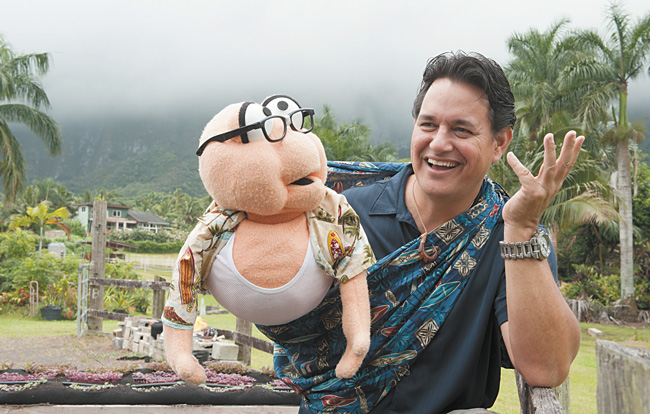On Waltah’s Farm
Palaka Moon Farm
On this particular morning, the farm is quiet, overcast with clouds and soggy from the morning rain. It’s a gloomy, gorgeous scene.
Walking around the farm, Smith is a source of unwavering enthusiasm.
At the Chicken Tractor, she coos to her “girls,” explaining that, altogether, they produce 42 eggs every week.
In another area of the farm, she stands before a large mound of “hot heap” (otherwise known as horse manure). Happily, she walks around, explaining the composting system before heading over to rows of farm pods.
Here, microgreens such as kale, spinach, radish, collards and many others are growing. In one cycle alone, the farm harvests 200 pounds of leafy greens.
There are nine learning stations like this in total that allow students to gain hands-on understanding of concepts introduced in the TV show. At the farm, it is students who sift soil then plant microgreens in it, harvest lettuce to make a salad or grind ‘ulu (breadfruit) to produce gluten-free flour. Smith hopes to eventually have more than 20 learning stations.
It’s a project five years in the making after Sustain Hawaii partnered with Dave and Michelle Campbell, who lease the land from the state Department of Agriculture. Funding from Harold K.L. Castle Foundation went to creating each interactive learning station — and it’s only the cusp of what Sustain Hawaii hopes to accomplish.
“If we can figure out ways for kids and anybody to shift their lifestyle in a certain direction and live simply but healthily, and then preserve the aina as well, I think that’s critical,” says Kevin Vaccarrello, founder of Sustain Hawaii.
For the time being, this stillnew farm is learning as it goes, garnering as many community partners as it can and having fun along the way.
“We live it and we breathe it and we love it,” says Smith. “We love Waltah, we love the farm, we love the ‘aina. “It’s so reciprocal, and so we’re just hoping other people will come and play with us.” F
For more information about Waltah the Worm and to donate to the program, visit waltah.com/fundraiser/waltahtheshow. A schedule of episodes is available at oc16.tv, and all also are available to view on YouTube by searching “Sustain Hawaii.”






